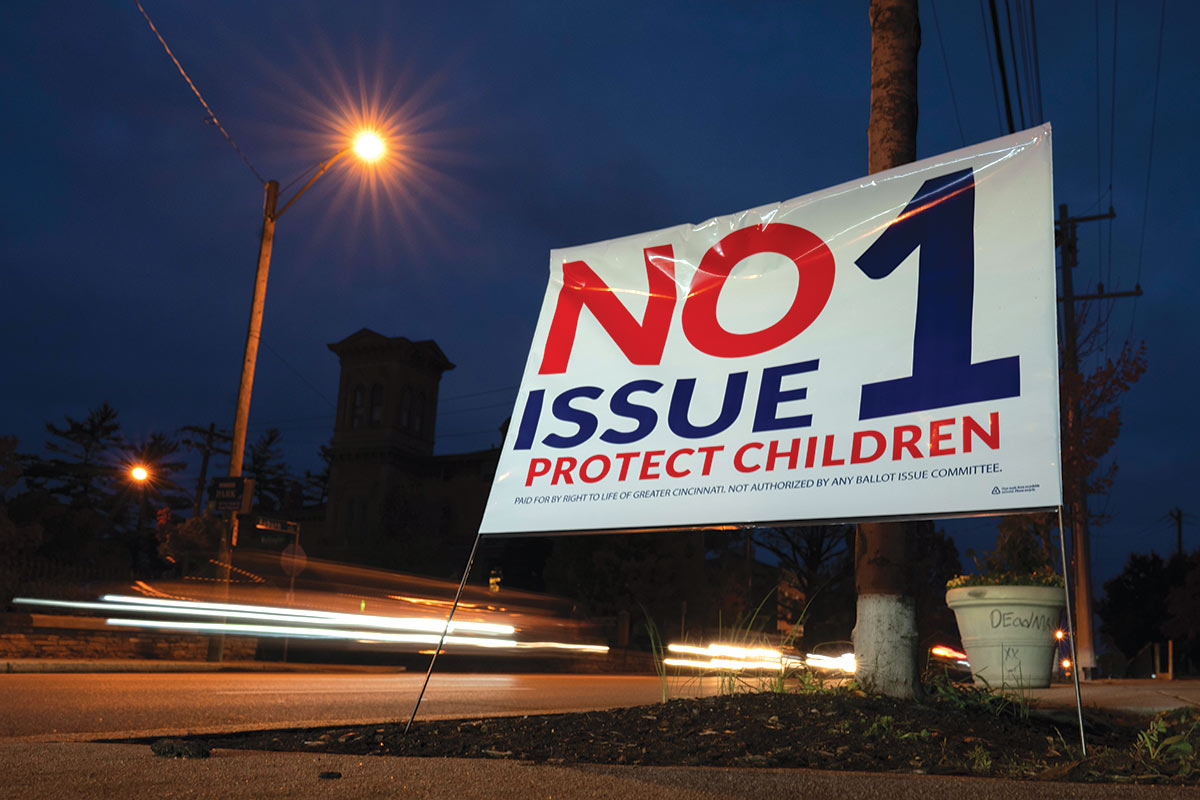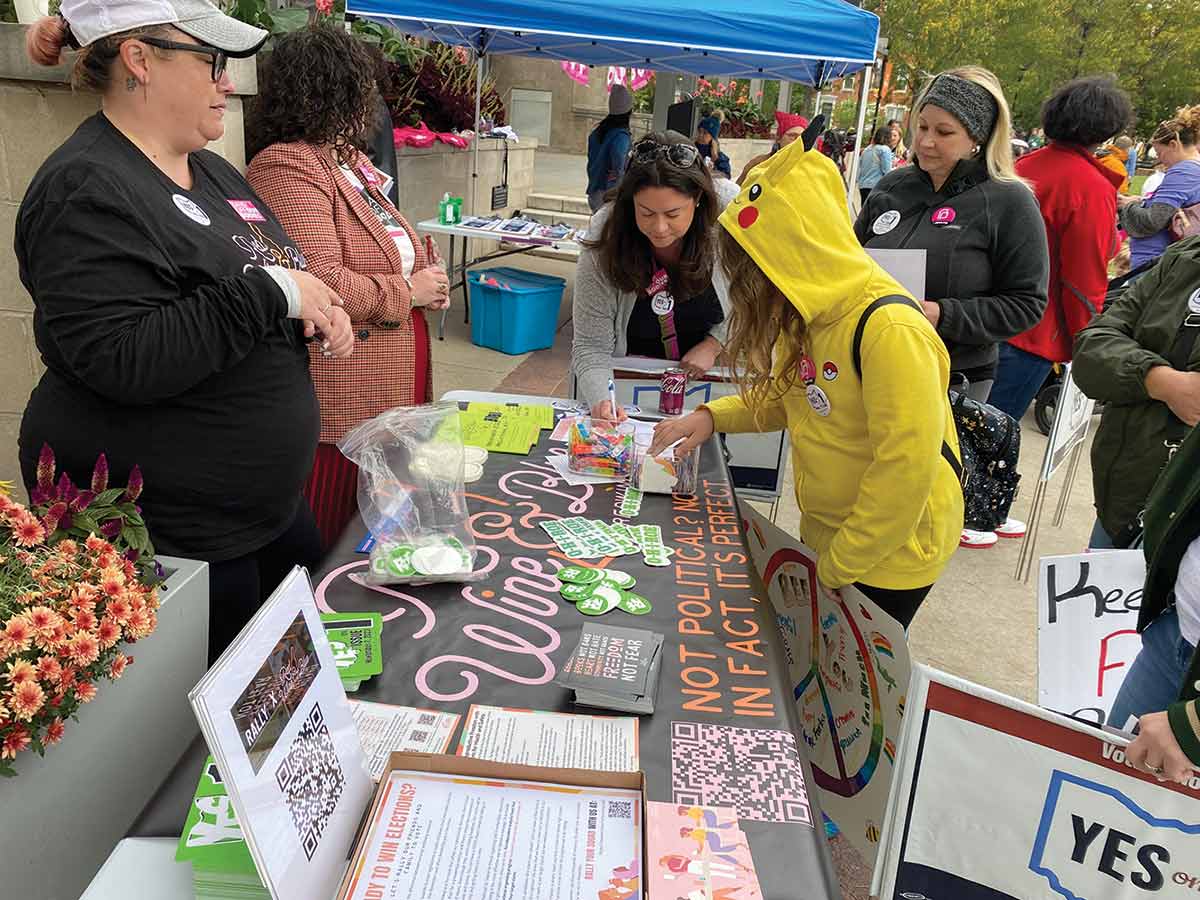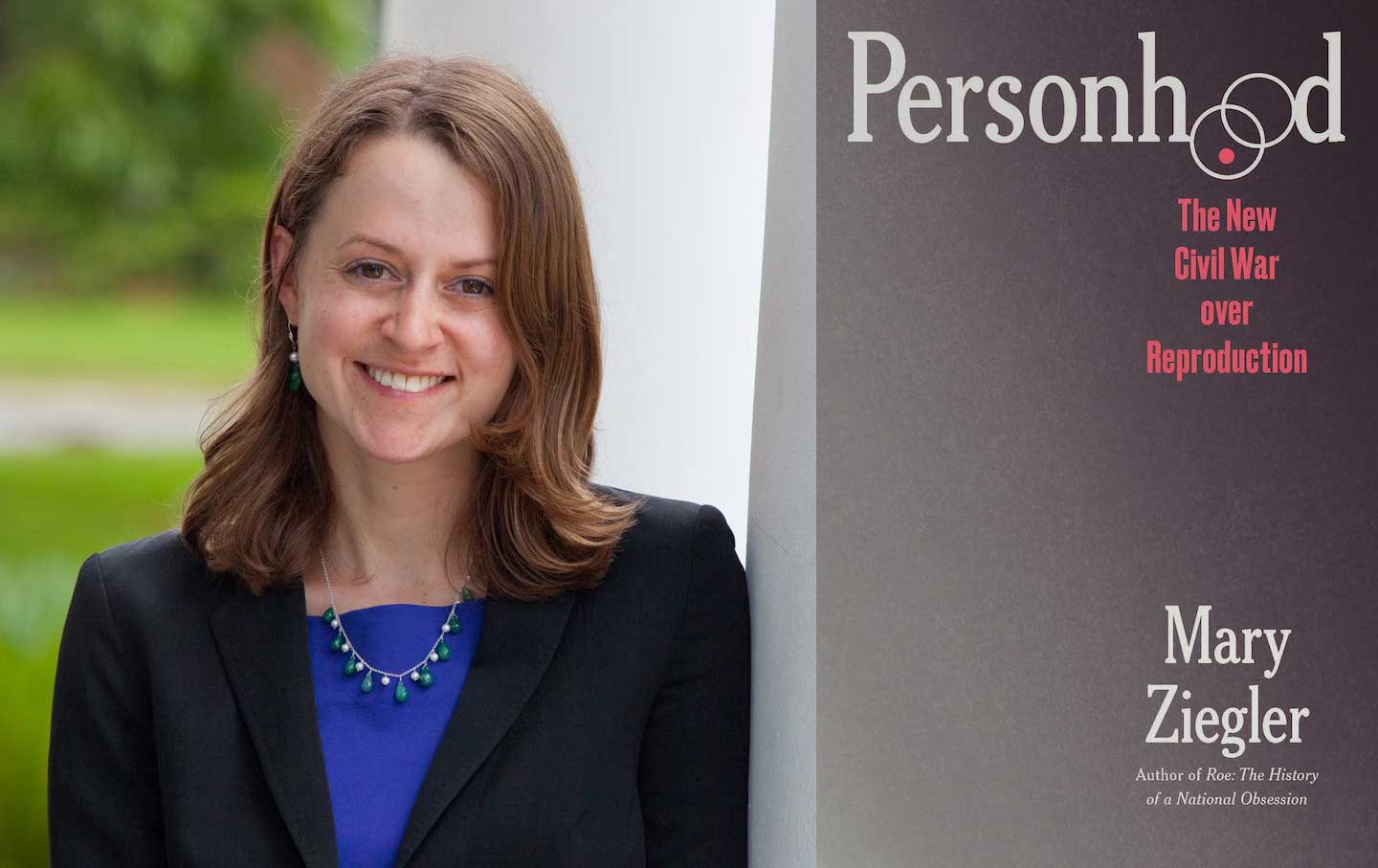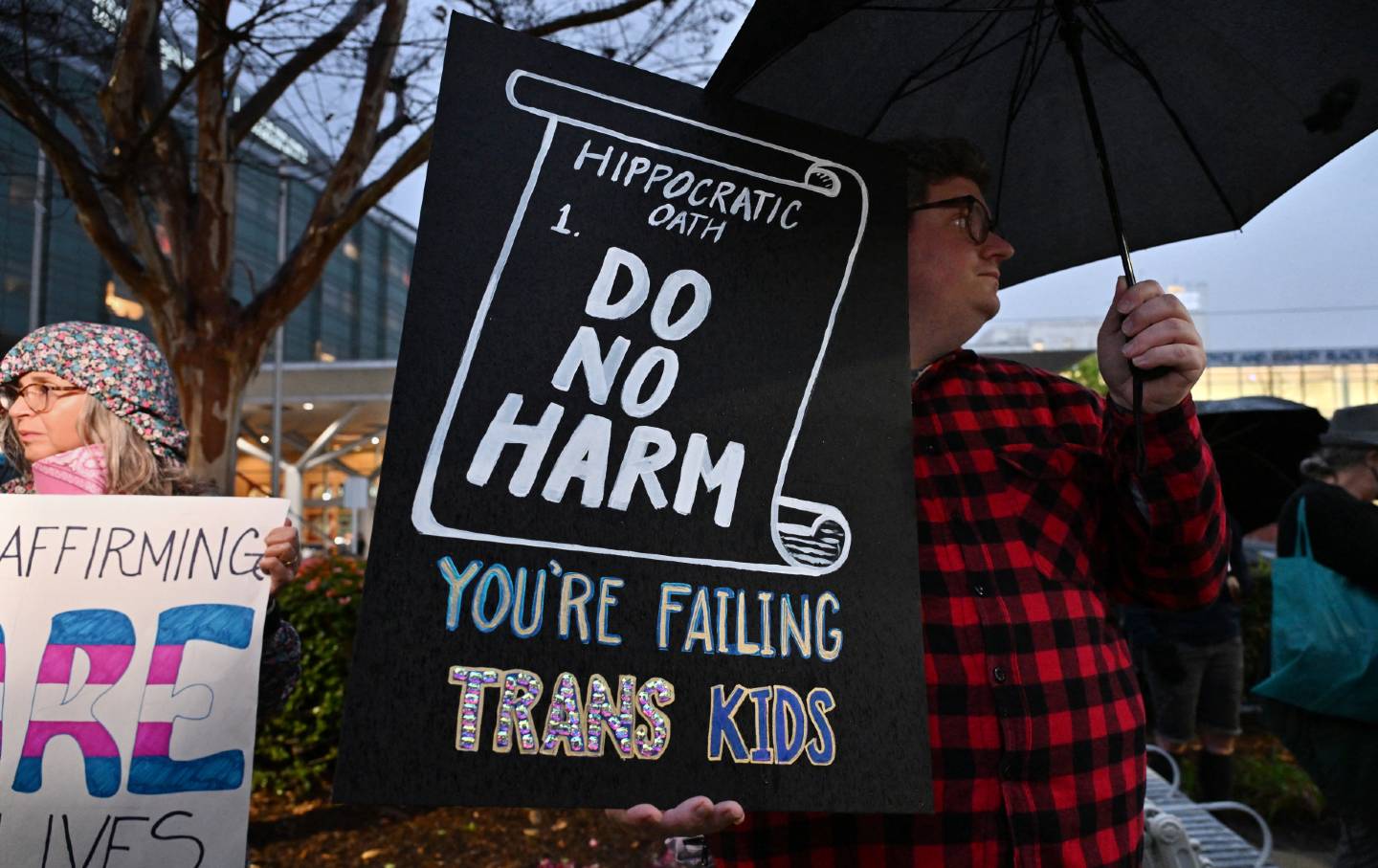How Ohio Passed the Highest-Stakes Abortion Rights Law Since Roe Fell
How Ohio Passed the Highest-Stakes Abortion Rights Law Since “Roe” Fell
The state is now firmly held by Republicans, but organizers found a way to reach voters who are appalled by the overturning of Roe v. Wade.

Jen Perez knows what it’s like to grow up in what she calls “a very typical Midwest, religious, Republican family.” Talking critically about politics, hashing out issues, and asking probing questions were frowned on, and she voted Republican once she came of age simply because the party’s values were in line with the way she’d been raised. After college, she worked for two decades as an engineer in corporate America, then left her job in May 2022, just before the Supreme Court’s Dobbs ruling. Donald Trump’s election in 2016 had sparked in her an interest in politics, but it wasn’t until Roe was overturned that she knew she needed to make a big change. Perez, now 42, who lives in a suburb of Cincinnati, looked at her then-7-year-old child and thought, “My daughter now has less rights at her age than I did.”
Perez is now the state program director for Red Wine & Blue, a national organization that, with a sly nod to the stereotype that suburban moms are too busy sipping merlot to pay attention to politics, has set out to mobilize women who support progressive policies but are underestimated and untapped by legacy left-leaning organizations. In Ohio, RWB became part of a coalition of groups with a huge goal: to pass a ballot initiative, called Issue 1, that would enshrine the right to abortion, as well as the rights to miscarriage care, contraception, and IVF treatment, in the state’s Constitution. On November 7, the coalition succeeded: Voters resoundingly passed Issue 1, 57 to 43 percent, making Ohio the seventh consecutive state since Dobbs in which voters have protected abortion access.
Until recently, Ohio was considered a battleground state, but Trump’s back-to-back wins have eroded Democrats’ confidence. The state has one Democratic senator, Sherrod Brown, who was first elected in 2006 and is up for reelection next year. Its freshman senator is Republican J.D. Vance, a former Never Trumper whose win in 2022 can be credited in part to his sycophantic relationship with the former president. Republican supermajorities in the state House and Senate and in its US congressional delegation have come as a result of the party’s power to draw district lines.
Such a political landscape might inspire total capitulation on the part of progressives, but the Supreme Court’s overturn of Roe lit a fire under reproductive health, rights, and justice advocates in Ohio. Local anti-choice activists have been trying to outlaw abortion for decades; with Roe gone, they’ve nearly gotten their way. In 2019, the state Legislature had passed the so-called “heartbeat ban,” which prohibited abortion after six weeks. It was blocked by a federal judge, but then the Supreme Court issued its Dobbs decision. The ban went into effect the next day, immediately halting scheduled abortions and throwing the state’s clinics into chaos. “We were just not anticipating a total loss within a matter of hours,” Jordyn Close, the deputy director of the Ohio Women’s Alliance, said on the What’s Good Ohio?! podcast in June.
Planned Parenthood and the ACLU quickly sued to lift the six-week ban, and a judge in Hamilton County issued an injunction late last year, putting enforcement of the ban on hold until the case could be decided by the state Supreme Court. The court’s stay put the gestational limit on abortion at 22 weeks. But during the 82 days when abortion was essentially illegal, Ohioans seeking the procedure were forced to either carry to term or flee the state to find care. In one well-publicized case, a 10-year-old rape survivor had to go to Indiana for an abortion. She was not the only minor who had to travel: Ohio’s six-week ban makes no exception for rape or incest. In another case, an expectant couple was devastated to learn of a fetal abnormality at 18 weeks and had to leave the state to terminate the pregnancy.
Stories like these galvanized reproductive health advocates in the state, including doctors. In the wake of Dobbs, a group of physicians founded Ohio Physicians for Reproductive Rights. In February of this year, the newly organized doctors and other advocates announced they would come together under the umbrella of Ohioans United for Reproductive Rights (OURR) to push the initiative in 2023. Issue 1, as it would come to be known, enshrines an “individual right to one’s own reproductive medical treatment” in the state Constitution. Red Wine & Blue, Planned Parenthood, Ohio’s ACLU, and Pro-Choice Ohio are in the coalition, as are the Ohio Women’s Alliance and New Voices for Reproductive Justice, both of which work primarily in Black, brown, young, and queer communities. OURR’s first step was to collect signatures to get the amendment on the ballot; they far surpassed the required 413,000 signatures, gathering more than 700,000. Jordyn Close, who lives in the Columbus area, had a well-practiced pitch prepared but often didn’t need to use it. As she told the What’s Good Ohio?! hosts, people would see her abortion rights T-shirt and approach her, asking to sign. It was clear that Ohioans were ready to vote on abortion in 2023.
While Ohio was the only state with an abortion-related ballot initiative this year, it would join six others where voters have been asked to weigh in at the polls since Roe’s reversal. In 2022, voters in Kansas, Kentucky, and Montana rejected efforts to further restrict abortion access, while in California, Michigan, and Vermont, voters approved measures to protect the right to abortion in their state constitutions. Ohio’s measure resulted in expanding access after it had been taken away. But the state has little in common culturally or politically with California or Vermont, and it is also more conservative than Michigan, where Democrats currently control both the statehouse and the governorship. “Unlike some of the other swing states where they had those blue waves [in 2022], we didn’t see that in Ohio,” Rhiannon Carnes, the executive director of the Ohio Women’s Alliance, told me.
Still, she and other abortion rights advocates in the state took a cue from those midterm wins. “We knew that the majority of Ohioans support access to reproductive freedom,” Close told me. Statewide, support for abortion access has consistently polled at nearly 60 percent since the fall of Roe. “Ohio is full of hardworking families and hardworking people,” Carnes said when asked how she’d characterize the state’s voters. This framing was my introduction to the campaign’s messaging, which seemed intended to appeal to a broad swath of voters, including self-identified moderates and centrists and even those Republicans who feel that government interference and Christian fundamentalism have an outsize influence in policymaking.
As of mid-October, OURR reported having knocked on more than 200,000 doors and made more than 700,000 phone calls to voters. The state’s AFL-CIO had come out in support of the abortion rights amendment, arguing that abortion access is essential to women controlling their economic futures. The musician John Legend, an Ohio native, urged a “yes” vote on Issue 1, as did the actors Kathryn Hahn and Busy Philipps. OURR released a steady stream of ads featuring a range of stakeholders: a faith leader; a couple forced to flee the state for an abortion when the six-week ban was in effect; a middle-aged white dad who grew up in the church and had been anti-choice but then had a change of heart. The results of a Baldwin Wallace University poll released in mid-October revealed that 58 percent of likely voters supported the constitutional amendment, including 89 percent of Democrats, 39 percent of Republicans, and 51 percent of independents. At the polls, Ohioans would also be voting on a measure to legalize marijuana for recreational use. (That measure passed with 57 percent of the vote.) Election observers anticipated a kind of synergy between the two issues, with voters who want less government interference in reproductive health decisions also preferring that politicians stay out of adults’ decision-making around cannabis use.

Throughout the campaign, polling suggested that abortion rights advocates had the majority of the state on their side, but thanks to anti-democratic maneuvering by Republicans at all levels in the state, the campaign was fighting an uphill battle.
After having watched abortion win at the polls in 2022, the anti-abortion forces in Ohio were nervous. OURR was planning to put an initiative on the November 2023 ballot to add the right to an abortion in the state Constitution. Republicans responded by proposing their own initiative, which would be put before voters in an August special election—known to have historically low turnout—that would raise the threshold for passing a ballot initiative to amend the Constitution from a simple majority to 60 percent. In 2022, Republicans in the statehouse had voted to eliminate almost all special elections held in August, but later reinstated an August special election when they realized that it might be the only way to defeat the initiative on abortion rights. Ohio Secretary of State Frank LaRose was caught on video telling the party faithful that changing the threshold was “100 percent about keeping a radical, pro-abortion amendment out of our Constitution.”
Many of the groups opposed to the amendment rallied in support of raising the threshold, including the Catholic Church and anti-abortion groups such as Susan B. Anthony Pro-Life America. Abortion rights advocates and other progressive groups lined up to oppose the measure—also called Issue 1—but so did moderates and Republicans who were concerned about the potential erosion of democracy. A bipartisan group of former governors came out against the change. On August 8, Ohioans soundly rejected Issue 1, with 57 percent of voters casting a “no” ballot to keep the threshold at a simple majority. Fifteen counties that voted for Trump in 2020 voted “no” on the proposal.
Popular
“swipe left below to view more authors”Swipe →There were also consistent efforts by anti-abortion groups to mislead voters. For example, the meaning of a “yes” or “no” vote switched between the August and November elections. In the summer, a “no” victory on Issue 1 meant that abortion rights would stand a greater chance of winning in November. In November, a “yes” victory on Issue 1 would enshrine the right to abortion in the state Constitution. LaRose’s office could have changed the name of the abortion-rights initiative but didn’t. Abortion opponents took advantage of the potential for confusion and designed their “No” signs for the November vote to look nearly identical to the “No” signs that were omnipresent over the summer.
Beulah Osueke, the interim executive director at New Voices for Reproductive Justice, said she’d witnessed uncertainty even among people who had followed the issues closely. “I spoke to someone in Columbus [who] was organizing her friends for the special election in August,” Osueke told me. “She said, ‘At times I’m confused—so now you’re saying to vote “yes” in November?’” A meme shared on the Moms for Ohio Instagram account used a hit song by Destiny’s Child to set the record straight. The pro-choice group posted a video of the pop group singing, “No, no, no, no, no, when it’s really yeah, yeah, yeah, yeah, yeah.” The caption read, “We voted NO in August and we’re voting YES in November.”
In late September, I tagged along with Paul Schaeffer, a volunteer with Planned Parenthood’s canvassing effort, as he knocked on doors in Wyoming, a suburb north of Cincinnati. Schaeffer is a professor of biology at nearby Miami University in Oxford, and he spent many of his weekends this fall working in Planned Parenthood’s field operation. I listened in as he spoke with people on a largely Black block of the quaint suburb. Edith Hardy, an elderly Black woman, was sitting on her porch with a middle-aged visitor, Fred Thomas. Hardy, a retired educator, told us she was regularly active in local elections and sometimes worked at the polls. But when asked what she thought about Issue 1, she hesitated, asking Schaeffer to refresh her memory. “So that vote in August, that was just to get it on the ballot?” Thomas said. Then he expressed exasperation: “I tell young people, ‘Y’all really need to pay attention to what these Republicans are doing.’”
The use of deceptive language was rampant in the anti-abortion campaign. In October, the Ohio Debate Commission partnered with local news organizations to host a debate on Issue 1. Mehek Cooke, a Columbus-area attorney and GOP operative, repeated the phrases “late-term abortion” and “partial-birth abortion” again and again. In fact, Ohio’s amendment allows the state to limit abortion after fetal viability (about 24 weeks), though the procedure could be performed after that point if a doctor deems it necessary for the pregnant person’s health. But Cooke’s talking points showed that including a viability limit doesn’t stop anti-choice activists from invoking the specter of an epidemic of later abortions. At the polls, voters read a summary of the amendment, written by the state’s GOP-controlled ballot board, that referred to an “unborn child” rather than “fetus” throughout.
In addition to lifting the design of their “No” signs from the August election, the initiative’s opponents started including the phrase “Protect Children” or “Protect Parents’ Rights” at the bottom of their signs. Anti-abortion advocates claimed that the amendment would take away the need for parents to consent to their children’s reproductive healthcare. Opponents argued that if those who crafted the amendment had intended only to protect adults’ access to reproductive healthcare, they would have used the word “woman” rather than “individual.” They also claimed that the constitutional amendment would open the door to “cross-hormone therapy, transgender surgeries, painful surgeries that we don’t want our children to go through,” all without the consent of a parent, as Cooke argued during the debate. The attacks were baseless, and even Ohio’s Republican attorney general, Dave Yost, acknowledged in a legal analysis that the amendment did not address parental consent, though he added that the use of the word “individual” would expose parental consent and notification laws to legal challenges.
Yet the right-wing disinformation caught on. “We are having conversations every single day with so many women on the ground, and we hear what they’re hearing,” Katie Paris, the founder of Red Wine & Blue and an Ohio resident, said prior to the election. Someone canvassing with the Issue 1 campaign might not have been able to effectively intervene in the spread of such disinformation, but friends of those caught in the loops of lies and distortions can. That’s why Red Wine & Blue has embraced a “relational organizing” model, in which ordinary people equip themselves with facts and then have conversations about politics with their friends and family members. “It’s just common sense. Your friends trust you. They believe in you,” Julie Womack, head of organizing at RWB, told the grid of about two dozen faces attending a Zoom training session on how to stop state and local abortion bans one evening in early October. “We are reaching people that campaigns may never try to reach,” she added.

While suburbanites breaking free from conservative dogma might need one approach, voters in the state’s cities—particularly Black voters—need something else, Petee Talley told me. Talley is the founder and executive director of the Ohio Unity Coalition, an organization that focuses on educating and turning out low-propensity voters. OUC works to demystify the voting process, making sure people know about early voting, how to get an absentee ballot, and how to find their polling place. In the aftermath of the August special election, Talley wrote a blog post challenging the idea that voters’ rejection of the effort to raise the threshold had solely been about abortion rights. In urging a “no” vote that summer, Talley had talked with Ohioans about raising the minimum wage and preventing police violence. They would have been limited in their ability to weigh in on those issues too if Republicans succeeded in making it more difficult to pass ballot initiatives amending the Constitution, she explained. While Black Ohioans’ opinions about abortion vary, their broad commitment to protecting progressive values is consistent. “Black voters will show up to [ensure] that all rights are protected,” Talley told me.
In pivoting to a focus on November, Talley’s group defined reproductive freedom as being about abortion, yes, but also about power and control. Their talking points included the fact that Black women are disproportionately affected by abortion bans, and their choices could be criminalized as a result. The messaging worked: 83 percent of Black voters supported the amendment, according to a Washington Post exit poll, compared with 73 percent of Latino and 53 percent of white voters. Osueke of New Voices for Reproductive Justice agreed that the outreach done by many of the more mainstream progressive and reproductive rights organizations didn’t resonate with the Black, brown, queer, and young voters her organization works with. She and others in the reproductive justice movement found ways to make Issue 1 feel relevant to voters’ lived experience. That meant “talking about liberating ourselves from government control and interference,” Osueke told me. Her organization is also committed to identifying community leaders, developing their skills, and engaging people in mutual aid projects. “This election is a tool that’s available to us,” Osueke told me. “It’s not the end-all, be-all.”
Progressive groups are now looking to 2024, when redistricting will likely be on the ballot. If the anti-gerrymandering amendment passes and a new citizen-led commission redraws districts fairly, Republicans could lose their hold on the statehouse. Senator Sherrod Brown is up for reelection next year as well. His Republican challengers, including Secretary of State LaRose, have all said they would support a national abortion ban if elected. Meanwhile, the state’s GOP has promised to try to neuter the abortion rights victory and has floated the idea of stripping courts of their ability to implement the amendment. Ohio Senate President Matt Huffman has called the November 7 win “just the beginning of a revolving door of ballot campaigns to repeal or replace Issue 1.”
“I would think we’re on the verge of actually coming back to a place where Ohio will once again be viewed as a competitive state,” Talley said. “But the shift has to start internally.” That means Ohio’s network of progressive groups will have to make sure they’re effectively reaching people with messaging tailored specifically to Black voters, rural voters, and other constituencies, she added. In late October, I spoke with Alexis McGill Johnson, the president and CEO of Planned Parenthood, who was in Cincinnati to canvass with Issue 1 supporters. She told me she’d toured a Planned Parenthood health center that provides abortions and asked a staffer there where the patients were traveling from. “I expected to hear Kentucky, Oklahoma; I expected to hear people in this region,” she told me. “[The staffer] said Florida and Montana. It’s 900 miles. It just blows your mind, the swath of the country that is without access.” But thanks to voters, Ohio will remain a safe haven for reproductive care in a post-Dobbs nation.
Hold the powerful to account by supporting The Nation
The chaos and cruelty of the Trump administration reaches new lows each week.
Trump’s catastrophic “Liberation Day” has wreaked havoc on the world economy and set up yet another constitutional crisis at home. Plainclothes officers continue to abduct university students off the streets. So-called “enemy aliens” are flown abroad to a mega prison against the orders of the courts. And Signalgate promises to be the first of many incompetence scandals that expose the brutal violence at the core of the American empire.
At a time when elite universities, powerful law firms, and influential media outlets are capitulating to Trump’s intimidation, The Nation is more determined than ever before to hold the powerful to account.
In just the last month, we’ve published reporting on how Trump outsources his mass deportation agenda to other countries, exposed the administration’s appeal to obscure laws to carry out its repressive agenda, and amplified the voices of brave student activists targeted by universities.
We also continue to tell the stories of those who fight back against Trump and Musk, whether on the streets in growing protest movements, in town halls across the country, or in critical state elections—like Wisconsin’s recent state Supreme Court race—that provide a model for resisting Trumpism and prove that Musk can’t buy our democracy.
This is the journalism that matters in 2025. But we can’t do this without you. As a reader-supported publication, we rely on the support of generous donors. Please, help make our essential independent journalism possible with a donation today.
In solidarity,
The Editors
The Nation








